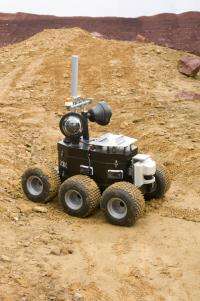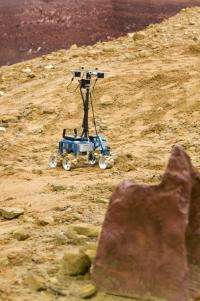Revolutionary navigation system for future Mars rovers

(PhysOrg.com) -- An autonomous navigation system that will enable a future planetary rover vehicle to be in complete control of its own actions as it explores the surface of Mars is being designed by top-calibre scientists and engineers at STFC’s Rutherford Appleton Laboratory. The team from the UK, France and Canada are joining forces to design ‘Seeker’ as part of the European Space Agency’s (ESA’s) StarTiger initiative, which tackles specific space-related challenges through targeted projects with fixed timeframes. Details of Seeker’s development were unveiled today on the day STFC’s RAL Space is holding its 7th Appleton Space conference.
The high level conference organised by RAL (Rutherford Appleton Laboratory) Space, brings together leading figures from the global space industry to share the very latest developments in current and future space exploration; this year’s programme features a video address from the Rt Hon David Willetts MP, Minister of State for Universities and Science. The StarTiger-Seeker project, led by RAL Space, is a seven month project that will see the team work intensively day and night to design a navigation system that, unlike previous systems, will enable a rover to navigate around Mars totally independently, covering at least 1km a day. The Seeker navigation system will allow a rover to react better to its surroundings and undertake experiments in more locations, enabling our understanding of the Red Planet to take a major leap forward.
Designed for use on future missions to Mars, Seeker will perform a range of key actions completely unaided by Mission Control or by GPS-type technology. These include: identifying the precise location of the rover on Mars, identifying promising scientific opportunities; long-range pinpointing of particular sites to visit; detecting and avoiding hazards; and navigating back to previously visited sites. It is expected that the Seeker technology will also have potential applications here on Earth, particularly in inhospitable environments.

The Seeker team includes experts from RAL Space, SciSys, BAe Systems, Roke Manor Research (all from the UK), LAAS (France) and MDA Space & Robotics (Canada). It will apply leading-edge skills in autonomy and intelligence, electronic sensing, image processing and other disciplines to tackle the huge challenges presented by the project.
Kim Ward of RAL Space, the Project Director, says: “The keys to Seeker’s success will be imagination, application and team work. With radio signals to conventional rovers taking at least 30 minutes to travel between Earth and Mars, Seeker’s ability to work autonomously in hostile terrain will be crucial to extending our understanding of our planetary neighbour.”
David Willetts said: "Space captures the imagination of so many people, and it’s excellent to see UK experts playing such a significant role in the groundbreaking StarTiger initiative. The Seeker project has the potential to transform our exploration of Mars and make an important contribution to the international body of knowledge on the universe around us."
The UK Space Agency (UKSA) was instrumental in bringing the ESA StarTiger project to the UK, through working with ESA Harwell (ESA’s only UK base) and securing funding for ESA Harwell’s establishment as a focus for space exploration.
Among those attending today’s Appleton Space Conference are Jean-Jacques Dordain, Director General of ESA, and Robert Cabana, Director of the Kennedy Space Centre in the USA.
Also at the conference, the President of UrtheCast, Scott Larson, gave more details about RAL Space’s plans to design and build two cameras that will provide the first-ever live video feeds from space. The cameras will be installed on the International Space Station now in orbit around Earth.
Provided by Science and Technology Facilities Council


















